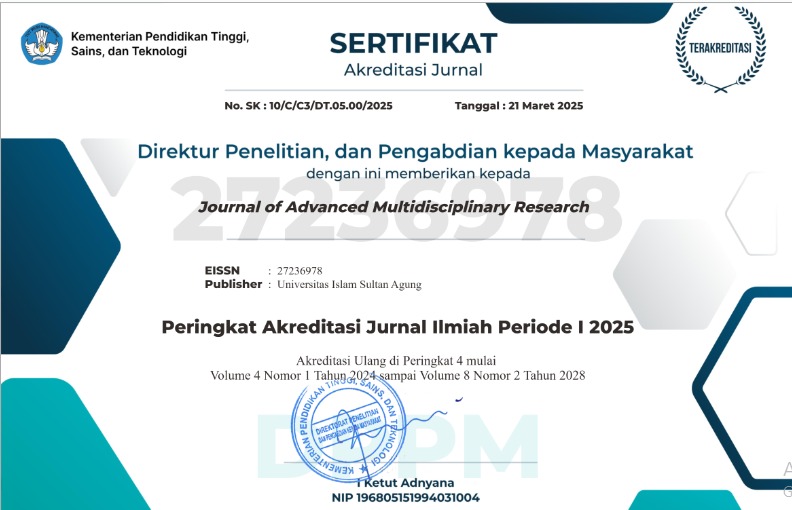Developing the English Teaching Materials to Improve the Students’ Speaking Skills (Case Study at Private MTs Jepara)
Abstract
This study aims to produce a product in the form of English learning textbooks to improve skills speaking, describe the design and implementation of English teaching materials that have been developed to improve speaking skills, describe the effectiveness of developing English teaching materials to improve speaking skills. This research includes the type of research and development (R&D) with stages, namely theoretical and practical studies, field studies, analysis of student and teacher needs, preparation of prototypes, expert tests, prototype revisions, limited trials, evaluations, and revisions of learning models. The population and sample of the study consisted of 40 students of class VIII MTs Walisongo Jepara. Collecting data using the method of observation, interviews, and literature study. This research focuses on the process of learning English for class VIII with the development of teaching materials as media used in English lessons. This research uses the qualitative data analysis method with data reduction, data presentation, conclusion or verification. The results of the study indicate that the design of developing English teaching materials to improve speaking skills is based on the principles of developing teaching materials which include accuracy of coverage and accuracy of content, completeness of components, presentation of language, and appropriate illustrations. The implementation of teaching materials was carried out 4 times in a limited trial. The development of English teaching materials to improve speaking skills was declared effective with an increase in students’ speaking skills in the psychomotor aspect with a mean pretest score of 73, and post-test 91, with an increase in N-Gain of 0.66 in the medium category.
Keywords
Full Text:
PDFReferences
Bedimo-Rung, A. L., Gustat, J., Tompkins, B. J., Rice, J., & Thomson, J. (2006). Development of a direct observation instrument to measure environmental characteristics of parks for physical activity. Journal of Physical Activity and Health, 3(s1), S176-S189.
Davis, C., & Wilcock, E. (2003). Teaching materials using case studies. C. Baillie (Series Ed.), The UK Centre for Materials Education. https://www. materials. ac. uk/guides/1-casestudies. pdf.
Devira, M., & Sarah, S. (2020). Analisis Prinsip Pengajaran dan Pembelajaran Bahasa pada Pengembangan Bahan Ajar Bahasa Inggris Sekolah/Madrasah Tsanawiyah (MTsN). In Seminar Nasional Peningkatan Mutu Pendidikan (Vol. 1, No. 1).
Gall, M. D., Borg, W. R., & Gall, J. P. (1996). Educational research: An introduction. Longman Publishing.
Gibbons, M. (2003). The self-directed learning handbook: Challenging adolescent students to excel. John Wiley & Sons.
Halliday, M. A. K., Matthiessen, C. M., Halliday, M., & Matthiessen, C. (2014). An introduction to functional grammar. Routledge.
Hartono, R., Mukhaiyar, R., & Ananda, A. (2020, December). A Development of Storytelling in Teaching English Speaking at Junior High School. In 2nd International Conference Innovation in Education (ICoIE 2020) (pp. 1-6). Atlantis Press. https://creativecommons.org/licenses/by-nc/4.0/.
Huberman, M., & Miles, M. B. (2002). The qualitative researcher's companion. Sage.
Huriyah, L. (2016). Peran Perpustakaan Keluarga dalam Meningkatkan Minat dan Keterampilan Membaca Anak. JOIES: Journal of Islamic Education Studies, 1(1), 63-86.
Indonesia, P. R. (2003). Undang-Undang Republik Indonesia Nomor 20 Tahun 2003 Tentang Sistem Pendidikan Nasional.
JIMÉNEZ NIÑO, P. K. (2015). Exploring students' reactions when working teaching materials designed on their own interests. Cuadernos de LingüÃstica Hispánica, (25), 201-222.
Maba, W. (2017). Teacher's Perception on the Implementation of the Assessment Process in 2013 Curriculum. International Journal of Social Sciences and Humanities (IJSSH), 1(2), 1-9. https://dx.doi.org/10.21744/ijssh.v1i2.26
Makrifah, N. (2020). Pengembangan bahan ajar Bahasa Inggris untuk meningkatkan keterampilan berbicara pada siswa MI Kecamatan Kwanyar Bangkalan. Doctoral dissertation. UIN Sunan Ampel Surabaya.
Nasional, D. P. (2005). Peraturan Pemerintah Nomor 19 Tahun 2005. Tentang Standar Nasional Pendidikan.
Neuman, W. Lawrence. (2013). Metodologi Penelitian Sosial: Pendekatan Kualitatif dan Kualitatif. PT. Indeks Jakarta.
Oktariyani, O., & Juwita, RP (2019). Pengembangan Bahan Ajar Bahasa Inggris Berbasis Local Learning Pada Siswa Sekolah Dasar. Syntax Literate; Jurnal Ilmiah Indonesia, 4(10), 103-115.
Prastowo, A. (2013). Pengembangan Bahan Ajar Tematik Panduan Lengkap Aplikatif. Dirjen Pendidikan Tinggi Depdiknas.
Richey, R. C., & Klein, J. D. (2014). Design and development research. In Handbook of research on educational communications and technology (pp. 141-150). Springer.
Sholichah, R. (2016). Pengembangan Media Card English Vocabulary dalam Pembelajaran Kosa Kata Bahasa Inggris untuk Siswa MI atau SD (Doctoral dissertation, tesis--Yogyakarta: UIN Sunan Kalijaga).
Sugirin, S. (2010). Affective Domain Development: Reality And Expectation. Cakrawala Pendidikan, (3), 85667.
Sugiyono. Prof, Dr.(2017). Metode Penelitian Kuantitatif, Kualitatif, Dan R&D. Alfabeta.
Supardan, H. D. (2016). Teori dan praktik pendekatan konstruktivisme dalam pembelajaran. Edunomic Jurnal Pendidikan Ekonomi, 4(1).
Tatto, M. T. (2006). Education reform and the global regulation of teachers’ education, development and work: A cross-cultural analysis. International journal of educational research, 45(4-5), 231-241. https://doi.org/10.1016/j.ijer.2007.02.003
DOI: https://dx.doi.org/10.30659/jamr.2.1.21-35
Refbacks
- There are currently no refbacks.
Copyright (c) 2021 Author(s)
Journal of Advanced Multidisciplinary Research (JAMR) is published by Research and Community Service Department (LPPM) Universitas Islam Sultan Agung Semarang, Indonesia.
Address: Jl. Kaligawe Raya Km. 4 Semarang, Indonesia.






